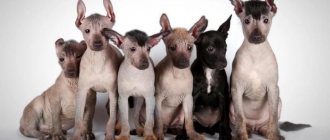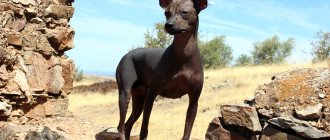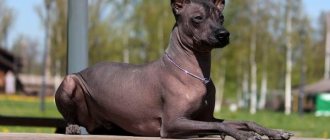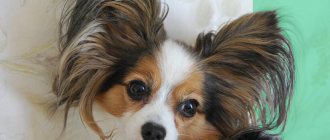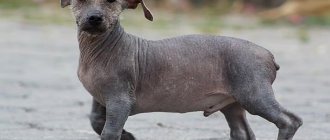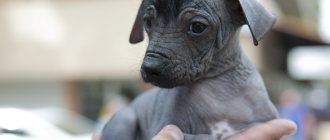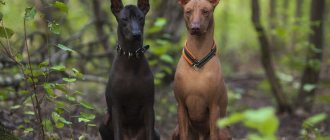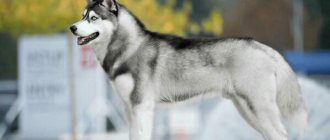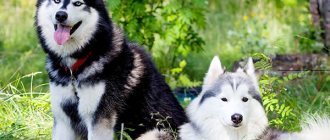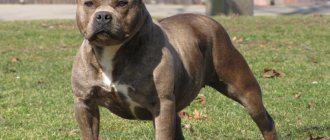The Xoloitzcuintle is a dog that has no fur. It is impossible to be indifferent to representatives of the oldest breed - they are either madly loved or disliked.
In Russia, Mexican hairless dogs are very rare, but interest in them is gradually growing. Let's find out what requirements such a dog must meet, what its advantages and disadvantages are.
Brief history of origin
The Xoloitzcuintle breed is considered one of the oldest on the planet. According to scientists, it has existed for about 5 thousand years. This is evidenced by numerous archaeological finds in the form of frescoes and figurines. The homeland of these animals is Mexico. The Aztecs, who lived on the South American continent at that time, noticed the unusual appearance of the dogs. She seemed scary due to her lack of fur. The Indians gave the bald animals a name consonant with the name of the god of the underworld. It was Xolotl, or Xolotl.
The Aztecs believed that xoloitzcuintles helped the deceased find their way to the afterlife. Therefore, after the death of a warrior, it was customary to kill his dog and bury him with the owner. At the same time, an arrow from a dead Indian was placed in the mouth of the four-legged friend. In Mexico, archaeologists have found many such graves.
On major holidays, the Aztecs prepared delicious dishes from local hairless dogs. Then it was believed that such food would help gain the favor of the gods and endow the participants in the meal with the gift of providence. The Indians believed that Xoloitzcuintle meat strengthened male strength. According to the ancient inhabitants of South America, the Mexican hairless dog helped to cure diseases.
With the advent of Spanish conquerors on the continent, difficult times came for the Xoloitzcuintle. The conquistadors tried to eradicate local beliefs and impose their religion on the Indians. For this reason, dogs began to be destroyed en masse, since in a certain sense they were an object of worship. At that time, the breed almost disappeared from the face of the earth. Several dozen animals survived and were located in remote villages in the mountainous area.
At the beginning of the 19th century, Europeans again showed interest in the wrinkled Mexican hairless dog. Elements of clothing and accessories for noble people were made from its skin. And only in 1850 the situation changed. There were people who came to the defense of the unusual breed. Then expeditions were organized to Mexico to search for surviving dogs for breeding. The efforts of the enthusiasts were rewarded. In 1887, the breed was registered with the American Kennel Club. However, they soon forgot about her.
The Xoloitzcuintle dog owes its true revival and recognition to Norman Pelham Wright, who in 1954 went to Mexican villages. He managed to find several representatives of the ancient breed.
The naturalist began breeding work, and at the same time wrote works on the history of hairless dogs. His book was called "The Solo Mystery." Mr. Wright developed a preliminary standard. Thanks to this man, the breed was recognized in its homeland in 1956. In Europe and America, its popularity began to grow. In 2011, the Xoloitzcuintle was registered with the AKC again.
Mexican Xoloitzcuintle mini: sizes, photos
According to canine requirements, this unusual breed comes in different sizes: mini, medium and standard. The most popular is the mini standard, since its miniature dimensions - from 25 to 35 cm - allow you to take it with you everywhere. Here is a photo of this dog:
XoloitzcuintleXoloitzcuintleXoloitzcuintleXoloitzcuintleXoloitzcuintle
- Mexican Xoloitzcuintle bitches differ from cables in their size. They are slightly smaller, which is due to their reproductive functions.
- The Xolo Mini's head is small and wedge-shaped.
- Despite its small size, it has a strong jaw with a tight bite.
- The tongue is usually pinkish, but may also contain black specks, which is typical for this breed.
- The eyes, like those of a large dog, are almond-shaped, the color scheme varies depending on the skin tone.
- The ears are bat-like and stand up when alert.
- The Xolo especially attracts attention with its graceful and graceful neck.
- Proportion and flexibility are emphasized by strong muscles.
When touched, the skin feels warm, smooth and soft, which requires additional care in the summer due to the lack of natural protection. Due to the lack of hair, this breed, even in extreme heat, occasionally breathes through its mouth, and sweat occurs through its paws.
Interesting Facts
There are many interesting facts associated with the Xoloitzcuintle breed:
- These dogs are twice included in the Guinness Book of Records, as they have the highest body temperature and belong to the oldest breed, which has remained unchanged for centuries.
- In Mayan times, xoloitzcuintles were considered guides to the other world, so they were treated with great trepidation.
- Representatives of this breed can jump high. It will not be difficult for an adult animal to find itself on the other side of a six-meter fence.
- Mexican Hairless Xoloitzcuintle dogs have proven themselves to be excellent watchdogs.
- Like Sphynx cats, these animals cannot be considered hypoallergenic. It is not the fur that causes the reaction in sensitive people, but the protein contained in the dog's secretions.
- This breed was first brought to Russia in 1986.
- There are only about 30,000 Xoloitzcuintle dogs in the world.
Training and education
Without proper training, a Mexican Hairless Dog can cause a lot of problems for its owner. An uncontrollable dog, due to its activity and curiosity, can even harm itself.
Raising and teaching Xolos different commands and rules of behavior is not difficult. These dogs are very smart, they quickly remember training lessons and fulfill requirements. They have excellent memory. But for the sake of such a result, the owner must be an authority for the pet, whose word is law.
Although aggressiveness is not typical for the Xolo, he is prone to dominance and loves to start fights with other people's dogs. Such behavior must be stopped, like any manifestation of aggression. The Hairless Mexican Dog is not made for fighting. Her skin is too soft and not covered with fur. So after even minor conflicts, your pet can get injured and scarred.
Interesting Facts
- In Mexico, the Sholoitzcuintle is a national treasure.
- The natives ate xolo meat, highly appreciating its taste and magical, healing effect on humans.
- Sholoitzcuintli was considered the earthly representative of the god Xolotl (from this the name). The purpose of these dogs was to accompany souls to the afterlife. The owner's funeral ended with the killing of his sholo, after which the dog's flesh was eaten.
- Xolo notifies the owners of the arrival of strangers by fussily rushing around the house.
Breed description, standards, appearance
This breed, according to the Fédération Cynologique Internationale classification, is included in group number 5, which is called “Spitz and primitive breeds.”
There are only three varieties of Xoloitzcuintle dogs. They differ from each other in body size.
| Type | Height at withers, cm | Weight, kg |
| Standard | 46-60 | 9-14 |
| Average | 35-45 | 6-10 |
| Mini | 25-35 | 4-8 |
Size and constitution
According to scientists, Aztec dogs, the ancestors of modern Xoloitzcuintles, belonged to the first, larger type. The body length of representatives of this breed is approximately 10% greater than the height at the withers. The body of males is slightly shorter than that of females. Dogs of both sexes look lean and fit.
Characteristics of the animals' exterior:
- The chest is narrow, but not excessively, its lowest point reaches the level of the elbow joints.
- The ribs are convex.
- The back is straight, with strong shoulder blades set obliquely.
- The lower back appears slightly raised due to more defined muscles.
- The croup is slightly lowered.
- The stomach is taut.
- The head is set high, its size is proportional to the body.
- The type of skull is similar to that of a wolf - strong with graceful lines.
- There is a slight protrusion on the back of the head.
- The muzzle is streamlined with smooth lines - the area under the eyes is well filled, while the cheeks are fairly flat.
- The tongue is pink or has dark markings.
- The stop is weakly expressed.
- Dry, thin lips fit tightly to the jaws.
- Long ears set high.
- The eyes are almond-shaped, with dry and dense eyelids.
- Scissor bite.
- A distinctive feature of the Xoloitzcuintle dog breed is the absence of premolars.
- The high neck blends smoothly into the withers.
- The front legs are dry, the elbows should be tightly pressed to the body and directed back.
- The forearms are set straight, and the pasterns are located at a slight angle. Paw type: hare.
- The muscles on the hind legs are well developed, especially in the hip area. The hock joints should be directed strictly parallel to the body.
- The tail is thin and of medium length. There may be a small brush at its end.
The dog moves freely. Her stride is long and elegant, and her trot is fast and smooth. While moving, the dog should hold its head and tail high.
Color and skin
From the photo of the Xoloitzcuintle, you might think that this is a dog without hair. However, hairless representatives of the breed still have a short and very sparse covering on the back of the head, on the forehead, toes and tip of the tail. The length of the hairs should not exceed 2.5 cm.
The breed also has a woolly variety. Such animals have cover all over their body. It is even, smooth and short, and there is no undercoat. Woolly dogs can participate in breeding provided that they are well built, have a beautiful exterior and color allowed by the standard.
The Mexican Hairless Dog has delicate, smooth and very sensitive skin that requires special care. Light-colored animals are susceptible to sunburn and therefore need protection from scorching rays. The Xoloitzcuintle's skin is hot to the touch.
The heat generated by the body is not retained in the fur due to its absence, so such dogs can freeze. The animal's body does not sweat when overheated. Cooling occurs through the paw pads and membranes between the toes.
Attention! Xoloitzcuintle puppies are covered in folds of skin. They are concentrated in the neck, head and forearms. As the animal grows, they become almost invisible. The standard allows the presence of shallow wrinkles on the forehead of adults.
Mexican dogs can have the following colors:
- light gray;
- dark grey;
- black;
- black-gray;
- golden;
- brown;
- bronze;
- red.
The standard allows the presence of points. The main thing is that they do not occupy more than a quarter of the surface of the dog’s body. The color of the nose also depends on the color of the animal. So, in Xoloitzcuintles with dark skin tones, it is almost black. In representatives of the breed with a bronze or golden color, this part of the body may be brown, or less often – flesh-colored.
In dogs with points, the nose most often has spots on the body.
The color of the iris should match the color. It happens:
- yellow;
- amber;
- coffee;
- brown;
- black.
American Hairless Terrier
The ancestors of the representatives of this breed were rat-catching dogs and hunting rat terriers. The first breeders were not too concerned about the appearance of the dogs, and paid more attention to their performance characteristics. Therefore, the fact that the modern exterior (by the way, it is the result of a gene mutation and the appearance of hairless puppies among representatives of the breed) causes such an ambiguous attitude.
Despite their not very attractive appearance, American Hairless Terriers have excellent qualities. These are very energetic and active, intelligent dogs that are easy to train and train. It's a pleasure to spend leisure time with them. At the same time, they are fearless and ready to stand up not only for themselves, but also for their owner. True, they demonstrate these latter qualities exclusively in extreme conditions.
Considering that their skin is not protected by a thick coat of fur, it is better to avoid long walks in the cold season and clashes with other animals.
American Hairless Terriers make good companions and friends. They can be owned by families with children, as well as those who already have other pets in the house. True, American terriers have an ambiguous attitude towards guinea pigs, rabbits, hamsters, and chinchillas. They may perceive them as game, remembering their hunting roots.
These dogs love it when their owners talk to them. An American Hairless Terrier can listen to its owner for hours, lying at his feet, and from his contented appearance it will be clear that this is what a dog’s idyll looks like.
When choosing a puppy of this breed, it is worth considering that they are born with a soft coat, which practically disappears by two months, leaving only a small beard, highlighting the eyebrows and sideburns.
A serious disadvantage of the breed is bob tail, albinism, merle color, and curly coat. Puppies with such characteristics are disqualified and are not considered to be carriers of the breed.
There are not many breeders breeding this hairless dog breed in the CIS countries. So, if you set out to get this dog, you will have to try hard to find a puppy. But even after you find it, don’t think that everything difficult is behind you. You will have to carefully care for your dog's skin, moisturizing it and protecting it from the cold. The skin of American Hairless Terriers gets dirty quickly, so it is better to immediately accustom your pet to regular water treatments several times a week.
Without proper physical activity, representatives of the breed begin to get sick. This is worth taking into account when planning your walking route. Be sure to include special training areas for dogs. Your four-legged friend will be delighted with this.
4
Disadvantages and disqualifying vices
The commission considers any deviation from the approved standard as a deficiency. The decision to reduce points is made taking into account the extent to which a particular defect affects the dog’s health or spoils its appearance.
The disadvantages of the breed include:
- head too wide;
- narrow body;
- short limbs;
- wrinkled skin in adult animals;
- light iris color;
- rounded eye shape;
- excessive dewlap;
- lordosis or kyphosis of the back;
- sloping croup;
- cow delivery;
- tail curled or touching the back.
Dogs that do not meet the standard and have too serious defects cannot take part in shows.
Why Xoloitzcuintles are disqualified:
- aggressive behavior;
- undershot or overshot;
- jaw distortion;
- heterochromia;
- blue eye color;
- deafness;
- blindness;
- tongue falling out of the mouth;
- short or docked tail;
- drooping or cropped ears;
- the presence of hair on the body of the hairless variety, except for the forehead, scruff, neck, tip of the tail and paws;
- long crest, like that of Chinese crested dogs;
- height less than 25 and more than 62 cm;
- any colors not provided for by the standard;
- albinism;
- cryptorchidism.
Attention! If a dog is born with extra toes, they must be removed. Otherwise, the dog will not be able to participate in exhibitions and championships.
A Brief Overview of Other Hairless Dog Breeds
In addition to the Xoloitzcuintle dog, there are other, no less interesting breeds that are devoid of hair.
American Hairless Terrier
The history of the breed began in the 1970s in the USA. But it has not yet received full official recognition. The good thing about a dog is that it almost never causes allergies, so it is adopted by those for whom this problem is relevant. Life expectancy is 15-16 years, which is generally not bad for hairless dogs. This is a small but active and dynamic dog. The wedge-shaped head is topped with V-shaped ears. The tail is mobile, saber-shaped.
He takes training well, is able to get along with other pets, and is loyal to cats.
The second well-known name of the breed is the American Hairless Terrier. The first such dog was born in 1972 from rat-catching terriers. The owner became interested in the lack of fur, and he began to identify and fix the gene responsible for it. To this day, the breed is considered rare.
Chinese Hairless Crested Dog
This is another crumb of the canine world - average weight - up to 5 kg, height - about 30 cm. The completely hairless body contrasts with the ears, decorated with long thick fur and limbs, also covered with hair. Long soft hair is also present on the tail.
The Chinese Crested Dog is an unusual and attractive pet.
Like Xolos, they can hardly tolerate loneliness, so busy people and those who periodically go on business trips should look for a different breed.
Note! These are incredibly smart animals that do their best to please their owner. They will conscientiously study any commands in order to earn the praise of their owner.
Manchurian Hairless Dog
Very similar to the Chinese corydalis, but almost completely devoid of hair. There is only a small bang. It has a slender build and thin pink skin. The average weight of such a dog is 7 kg, height at the withers is 24-32 cm. A kind and devoted dog will adore its owner, and perceive separation from him as punishment.
There is also an African Hairless Dog, very similar in appearance to its Manchurian relative. But this terrier is twice as large (weight up to 15 kg), cannot bark at all, only makes whining sounds when feeling pain or grief. Skin color is dark, close to black.
Note! The African Hairless Terrier is a wayward dog, the most complex in character among the hairless ones, it is difficult to train and requires a responsible approach.
Peruvian hairless dog
It is almost impossible to find such animals in Europe; even in their homeland - Peru - they are quite rare. The second name of the breed is the Peruvian Inca Orchid. It is believed that this dog is the protector of the home from the negative energy of ill-wishers. There is also the Egyptian Hairless Pharaoh Hound, another dog that can be confused with the Xolo.
The Peruvian Hairless Dog has an impressive and menacing appearance.
These are hairless dogs, creatures that are very interesting in appearance and have a wonderful character. They are smart, quick-witted and sincerely attached to their person, separation from whom they may not survive. When getting such a pet, you need to understand your responsibility.
*Price data is presented for December 2022.
Health and life expectancy
Xoloitzcuintle dogs naturally have strong immunity, since the breed was formed naturally, without the intervention of breeders. They rarely get sick, but these animals still have some problems. Mexican dogs are most susceptible to skin diseases - allergies, dermatitis. Animals with weakened immune systems may have fungus. In this case, a plaque with an unpleasant odor appears on the body.
Dogs living in regions with cold climates are prone to colds, so it is recommended to wear overalls or other clothing during winter walks. In summer, the Xoloitzcuintle's skin can suffer from sunburn. Another problem that occurs in these dogs is weak cartilage. It manifests itself in sagging ears.
The average lifespan of a Xoloitzcuintle with good care is 12-15 years. To keep your four-legged friend healthy, you need to follow feeding recommendations and get vaccinations according to the schedule. Vaccination will protect your dog from infectious diseases. It is also important to treat the animal for parasites.
Peruvian Inca Orchid
Hearing the name, many people want to look at photos of the breed out of curiosity. I wonder what such a dog looks like, which you rarely see in our area. A funny crest, the ability of the animal’s skin to change its color depending on the air temperature - all this turns representatives of the breed into sacred animals. In Peru they are treated like animal deities.
Where did the breed come from? Some experts say that it originated in Africa, while others claim that it was developed in China. Be that as it may, the images of these dogs on ceramic products from the civilization that lived before the Incas indicate that this breed is very ancient.
If you are lucky enough to find such a puppy, consider yourself to have won the Jackpot. These are very gentle and calm dogs that quickly get used to their owner and new family. The dog expresses its joy with a loud ringing bark. Representatives of the breed are devoid of aggression, but they are wary of strangers.
Another feature of dogs is that they prefer to be nocturnal, while during the day they sleep. This point will have to be taken into account, and if you want to rebuild the orchid’s internal clock, you will have to try hard.
Today there are three varieties of this breed:
- Mini (up to 8 kilograms);
- Medium (up to 12 kilograms);
- Maxi (up to 25 kilograms);
There are dogs with minimal fur and completely hairless. By the way, in order to get healthy and viable offspring, it is worth breeding dogs with different coats (hairless and hairless). Breed standards allow hairless dogs to have a tuft and tufted tail.
Albinism, deformed bite, and excessive hairiness are considered serious defects of the breed.
As for caring for these dogs, they need careful and delicate care for their delicate skin. However, you should not bathe them too often, because of the risk of disturbing the pH of the skin. For bathing, you must use special dog products for hairless dog breeds.
Character and behavior
Xoloitzcuintle dogs have a balanced and calm disposition. They become strongly attached to the members of the family in which they are raised, but usually have one favorite. He gets all the attention. The dog will not leave his object of adoration for a minute - he will accompany him everywhere, participate in all household chores. Sometimes the dog seems too intrusive, but he will calm down as soon as he gets what he wants - another portion of hugs. Close contact with the owner is very important for these animals.
Mexican dogs are smart and easy to train, the main thing is to start developing the character of the Xoloitzcuintle at an early age. The owner must firmly adhere to the rules he himself has established, otherwise the dog will feel weak and will certainly take advantage of it.
Representatives of this breed are prone to dominance and are not without egoism, so you need to be stricter with them.
The hairless dog is wary of strangers. She will not take her eyes off a suspicious person in order to protect her owner in case of a threat.
The Xoloitzcuintle may attack the offender, but will never show aggression without reason. This is a loyal and reliable friend you can rely on.
Breed and other animals
Puppies are friendly towards other pets, be it a cat or a dog. Adults do not tolerate the presence of anyone from the world of four-legged animals on their territory. They will always dominate and demonstrate their superiority in every possible way. However, if a Xoloitzcuintle is raised with a cat or other animal from childhood, there will be no disagreements between them in the future.
Breed and children
It is better not to get a Xoloitzcuintle for families with small children. Representatives of this breed, although they have patience, will not constantly ignore inept treatment of themselves. Such a dog demands respect for itself, so it is unlikely to be able to make friends with a baby who constantly pulls its tail. In addition, she is too sensitive to loud noises. For families with teenage children, a Mexican dog is suitable.
Xoloitzcuintle dog: reviews from owners
Xoloitzcuintle
The Xoloitzcuintle breed formed independently without human intervention, which is why these dogs are classified as primitive breeds. Such dogs are distinguished by good health, rarely have genetic diseases and are long-lived.
Here are reviews from the owners of these dogs:
- Artem, 24 years old My Alejandro is wonderful. He doesn't shed at all, is friends with everyone, playful, loyal, obedient. I always take it with me on trips, on vacation, and when I go shopping. When I lie down on the sofa after work, he will quietly lie down next to me. The only negative about it is allergies, which appear on the dog’s skin in the form of rashes. It took me a long time to select food for him.
- Nikita, 20 years old When my sister gave me a puppy, I immediately named him Baloo. He has a wonderful assortment in his wardrobe, and we constantly dress for walks in similar looks. Baloo is very smart, loyal, not picky about food, you can even talk to him, tell him about your experiences, and he looks straight at me with a knowing look and starts licking me.
- Nikolay, 48 years old I’ll tell you from my experience, I love dogs, but I didn’t get them for only one reason, that’s because they shed. But my son was once looking up dog breeds on the Internet, and I saw this miracle. The decision was immediate and I bought a Xolo dog. And now Rose is a favorite pet not only for our entire family, but also for our neighbors. If you are eager to have a pet that will constantly delight you, welcome you home, lift your spirits and create comfort in your home, then buy a Xoloitzcuintle, you will not regret it.
How to choose a pet
The Xolo dog is quite rare. Those interested in purchasing one will have to contact professional breeders. In Russia, there are Xoloitzcuintle nurseries in Moscow and St. Petersburg, in Ukraine - in Kyiv. In small towns it is unlikely that you will be able to find those who breed this breed.
To buy a good puppy, you need to talk to the breeder, find out more about the parents, their achievements and awards, and look at the documents. Most likely, you will have to book your dog in advance. Puppies are transferred to new families at the age of 3-4 months, a couple of weeks after revaccination against distemper, leptospirosis and intestinal infections.
The appearance of small Xoloitzcuintle puppies is a little off-putting. The baby's body is knocked down, the limbs are short, the skin is covered with folds. Such data should not confuse the buyer, since the physique will change with age, and wrinkles will smooth out.
When choosing a dog, it is better to pay attention to the animal’s temperament. It is worth giving preference to an active, playful and inquisitive puppy.
Where are the Xoloitzcuintle nurseries located?
Xoloitzcuintle
The Xolo breed requires a careful approach to choosing a puppy. In order to choose the right purebred pet, you need to contact specialists who are professional breeders and have a veterinary or canine education. They will competently talk about this breed, habits, health, character and lifestyle.
Kinich Ahau nursery is one of the best in Russia:
- This organization has all the necessary certificates and is registered with the International Canine Association.
- She has many World and European champions in her collection.
- Pets are winners of major exhibitions and receive excellent reviews from respected experts, demonstrating the beauty and grace of beautiful Xolos.
Pete?
Puppy care
When purchasing a dog, the breeder will give detailed recommendations on caring for the Xoloitzcuintle. After moving to a new house, you need to surround it with attention and care, play together, and walk outside. All this will help the puppy quickly recover from stress after separation from its previous owner and adapt.
One of the most important aspects of caring for a Xoloitzcuintle puppy is nutrition. Young animals are fed more often than adult dogs.
- At the age of 2 to 4 months, babies should eat 4-5 times a day.
- In the period from 5 to 9 months - 3 times a day.
- As dogs approach one year of age, they are gradually transferred to two feedings a day.
Chinese Crested Dog
A miniature dog with a crest on its head, for which it received the nickname crested. Always close to the person.
It has fairly long, lion-type fur on its head and legs. There is a tassel on the tail. The long, down-like coat requires combing and trimming.
The dog is very kind, but at the same time it is quite whimsical in its maintenance: it requires constant care, and easily gets sick from temperature changes.
If a dog is trained to use a litter box, it will be able to live calmly in an apartment.
Full description: Chinese Crested Dog
Care and maintenance
The Xoloitzcuintle dog is an ideal pet for an apartment or private home. She does not require much free space, as she is moderately active. Keeping an open-air enclosure outside is not suitable for an animal without fur.
Caring for a Mexican dog includes:
- carrying out hygiene procedures;
- diet planning;
- regular walks in the fresh air;
- dog training.
Hygiene procedures
Lack of hair does not mean that the Xoloitzcuintle is easier to care for. Yes, such a dog does not need combing, but its skin requires a more careful approach. Over time, a sticky coating forms on it, to which dust and lint stick. Therefore, your pet’s body needs to be washed regularly. About once every 2 months, the dog is bathed in a bath using hypoallergenic products.
In between water procedures, the Xolo's skin is wiped with animal cleansing wipes. You can use children's ones as they do not contain alcohol.
The Mexican dog requires careful care in the summer. Before going for a walk, it is advisable to apply sunscreen to your Xoloitzcuintle's skin. However, even when using it, it is better to walk in a shady park. When the heat is intense, the Mexican dog's skin quickly loses moisture and may peel. In this case, it is recommended to lubricate the pet’s body with olive oil.
Attention! Dogs of this breed may develop rashes on their bodies up to eight months of age. Special lotions and finely abrasive scrubs help cope with this problem. If a rash bothers an adult animal, it is most likely a manifestation of an allergy.
It is important to monitor the condition of your ears. Once a week they are cleaned with a cotton pad soaked in hygienic lotion. During the procedure, dirt is removed only from the external auditory canal. The inner corners of the eyes are wiped daily with a clean napkin or sponge.
The dog’s mouth also needs care. Teeth are brushed every 2-3 days with a special paste for animals. To prevent the formation of tartar, dental treats are introduced into the xoloitzcuintle's diet.
Twice a month, the dog's nails are trimmed so that it does not feel discomfort while walking. Scissors are not suitable for this. It is better to buy a guillotine-type nail clipper. It has an oval hole where the tip of the claw is inserted and quickly cut off. It is important to accustom your Xloitzcuintle puppy to hygiene from an early age, then the dog will behave calmly during unpleasant procedures.
Feeding
Xoloitzcuintles are prone to allergies, so their diet must be carefully monitored. You cannot feed a dog food from a human table. Representatives of the Mexican breed have an excellent appetite, so they can gain excess weight if the owner constantly follows the lead of a cute beggar.
Industrial feed
Veterinarians and professional breeders advise feeding Xoloitzcuintles with premium industrial food. They are properly balanced and contain all the necessary substances and vitamins for the normal development of the dog.
The best option is to switch your pet to dry food, since it does not spoil in a bowl even in the summer, when it is hot at home. But if your dog has dental problems, he should be given soft food.
Natural feeding
Many owners prefer to feed their Xoloitzcuintle natural food. In this case, it is important to properly balance the diet. It should consist of 60% high protein foods.
The main source of protein is lean meat:
- rabbit meat;
- chicken, turkey fillet;
- veal.
Once a week you can pamper your dog with sea fish, the main thing is to select all the bones. The Xoloitzcuintle menu also includes porridge, vegetables and fermented milk products. All dog food is prepared without adding salt or spices.
Strictly prohibited:
- pork;
- salo;
- sausage;
- sausages;
- human canned food;
- minced meat and meat that have not undergone heat treatment;
- fried food;
- smoked snacks;
- beans;
- bones;
- milk;
- bakery;
- candies.
Walking and exercise
The Mexican Hairless Dog should be walked at any time of the year, but not all weather is suitable for the boardwalk. It is better to go outside on windless, non-cold days when there is no precipitation. In autumn, early spring and winter, be sure to wear overalls on your pet. It will help prevent colds.
To maintain good shape, your dog needs moderate physical activity. Xoloitzcuintles love to run, jump and be active. Such animals love to overcome obstacles, look for a stick and bring it to the owner; they will enjoy canine freestyle classes.
Training and education
The Xoloitzcuintle has not only positive qualities. This dog is stubborn by nature, so you will have to work on shaping its character. It is important to start parenting at an early age. The dog must be taught to respect its owner and obey him unquestioningly.
With regular training, Mexican dogs learn well and easily remember commands. The main thing is that the four-legged friend feels the firm hand of the owner.
The Xoloitzcuintle does not tolerate lack of attention well. Because of loneliness, dogs often bark for no reason and behave badly.
Who is it suitable for?
A “bald” dog, as the Xolo is sometimes unkindly called, is a dog only for those who love animals and are ready to take care of them. A representative of the Mexican breed is categorically not recommended for busy people who are constantly missing at work. A pet needs communication with its owner, without whom it will suffer.
In addition, families with children should choose a different purebred puppy. A tiny hairless dog is not a living toy; careless movement by a child can cause injury.
The Mexican Hairless Dog is suitable for those who are willing to devote time and attention to it.
Xolo is suitable for responsible and serious people who already have experience in keeping dogs. The breed, for all its attractiveness, is distinguished by its disobedience, so the dog needs a strict but fair owner.
It is important to soberly assess your strengths, to understand whether it will be possible to constantly make preventive visits to the veterinarian, buy expensive food and clothing, shoes, and oil for skin care for your pet. If yes, then you can safely head to the nursery.
Puberty and mating
Show and breed class Xoloitzcuintle dogs aged 2 to 6 years are allowed for breeding. In Russia, mating of dogs of different sizes is allowed. The main thing is not to cross mini animals with the standard variety. This can cause puppies to have an imbalance between bone structure and body size.
Mating of dogs is carried out on the third day of the female's estrus in the male's territory. Pregnancy lasts on average 63 days. Slight deviations in one direction or another are possible. After giving birth, the female feeds the babies with her milk for 2-2.5 months. Xoloitzcuintles are caring mothers who never give up on their offspring.
Ecuadorian hairless dog
The rarest hairless dog breed is the Ecuadorian. She has less hair than all other dogs, including hairless dogs.
Now this rare species is found only in remote villages of tropical Africa. Very little is known about the breed. What is certain is that the dog is smart and energetic. Average life expectancy is 12 years .
Pros and cons of the breed
The Mexican Xoloitzcuintle dog cannot leave anyone indifferent due to its appearance. But before you decide to get such a pet, you should learn more about the advantages and disadvantages of the breed.
| pros | Minuses |
| Unusual appearance | Your dog's skin requires special care |
| Lack of hair makes it easier to care for | Insufficiently socialized dogs behave timidly and suspiciously towards strangers |
| Provided proper socialization, lives peacefully with other animals | Tendency to dominate |
| The dog is moderately active, playful, cheerful | The dog has a sensitive psyche; it is unsettled by loud sharp sounds, changes in the environment, changes in the daily routine |
| Has good watchdog qualities | Difficulties in choosing a partner for mating, since the breed is rare |
Possible diseases and methods of treating them
The most dangerous illness for Xoloitzcuintles is food allergies. Unfortunately, almost all representatives of the breed are prone to it. If this disease is present, the animal experiences the following symptoms:
- Itching.
- Redness of the skin.
- Nausea, possibly vomiting.
- Weakness.
- Increased tear production.
- Difficulty breathing, swelling of the nasopharynx.
Vaccinations given to your dog as a puppy will help reduce the risk of allergies. But, in order to definitely prevent its occurrence, do not give your pet food from the table, especially heat-treated food.
Since this Mexican breed has no fur, they are susceptible to dermatitis, a common skin condition. As it develops, the animal experiences severe itching.
The integrity of its skin is also partially compromised. The disease is provoked by poor diet and lack of hygiene procedures. Dermatitis in dogs, like food allergies, can only be treated by a veterinarian.
Well, the last thing that should be highlighted is limb injuries. The Xoloitzcuintle gets them often, especially during active games. Therefore, to minimize the risk of injury, do not throw objects high and far to your dog so that he does not have to quickly chase them, much less push off the ground to jump.
Xoloitzcuintle price
A pet-class Xoloitzcuintle dog costs about 10,000-15,000 rubles. This is an animal with documents, but there are flaws in its appearance that do not allow it to be used for breeding. Prices for breed class dogs range from 30,000-80,000 rubles.
The most expensive are exhibition animals, which can participate in various shows, championships and win awards. The cost of such dogs can reach 150,000 rubles.
The bald native of Mexico is undoubtedly worthy of attention, if only because she has a unique appearance. However, when choosing a pet, this is not the only thing to consider. It is much more important to choose an animal to suit your own temperament. The Xoloitzcuintle needs a strict but loving owner who will not allow the dog to break the established rules and push himself around.
Hairless Deerhound (Scottish Greyhound)
This type of Scottish greyhound arose as a result of natural selection. Today they are very rare.
They have a non-dominant “baldness” gene, which appears only a month after birth. Unlike Peruvian Hairless dogs, they have all teeth.
Since the main purpose of the greyhound in Scotland is hunting, representatives of the breed are currently practically not used.
The dog is weak and has delicate skin, so even during walks there is a high risk of injury.
History of the breed
Mexican Xolo
The Xoloitzcuintle is a breed that existed during the Aztec, Mayan and Toltec times. Its history began 3.5 thousand years ago. During this period, wild and domesticated animals were considered to have powers that helped protect and guard their owners.
The Mexican dog not only served as a guide to the Kingdom of the Dead after the death of the owner, but was also used as a delicacy of meat.
Before the arrival of Europeans it was considered sacred. Important! The Xoloitzcuintle (sometimes mistakenly called the Mexican Shepherd) is now the national dog of Mexico. Some people believe that she can heal the sick using her healing powers.
Attitude towards children and pets
Pets get along easily with younger family members and spend all their free time playing. Animals react adequately to children's pranks, with the exception of mini Xoloitzcuintles.
Important! Without timely socialization, dogs will be wary and aggressive towards strangers. There are usually no problems with pets.
Joint holiday
Egyptian Hairless (Pharaoh) Hound
Today, the image of the Egyptian dog is surrounded by an aura of myths:
- Myth No. 1: She is from Egypt. No, in fact, she is originally from Malta. And she was nicknamed Egyptian because of her protruding ears and resemblance to the pharaohs.
- Myth No. 2. The dog is bald. Also no. The dog is short-haired, but its fur is so short that it is considered hairless.
- Myth No. 3 The dog is very smart. The dog, despite its intelligent appearance, is quite stupid and difficult to train.
Full description: Egyptian Hairless Dog
Photo and video review
Photos of hairless dogs will help you decide on the color and appearance (hairless or hairless). And the specialist in the video will tell you in detail about the rules of maintenance, feeding and care. Will reveal the nuances of pets living in private homes.
The Mexican Xolo needs daily exercise, walks in the fresh air and communication with the owner. And if you follow all the rules, then over time you can get a devoted and best friend in the body of a dog.
Nutrition
The daily menu is compiled taking into account the Xolo's predisposition to allergic reactions. Abrupt changes in diet are prohibited. And new products are introduced gradually, monitoring health status. Not recommended:
- beef, chicken;
- fish, eggs;
- sweets, legumes;
- canned food, spices;
- baked goods, confectionery products.
To exclude allergies, give a small amount of the product. If there are no rashes or indigestion, increase the portion. Ideally, the diet of a hairless Mexican dog consists of one third of vegetables, cereals and dairy products, and two thirds of protein foods (turkey, rabbit, lean sea fish without bones).
Expert opinion
Anna Abramenko
An avid dog lover. Experience in veterinary medicine since 2009.
Ask a Question
After eating, your pet should be given time to rest. Otherwise, he may experience a volvulus.
Physical activity, proper nutrition and proper drinking regime are the key to good metabolism and health of a hairless dog.
Varieties
The breed is classified according to two parameters - size and the presence of hair. According to the first sign, miniature (25-35 cm), medium (35-45 cm) and standard (45-60 cm) hairless Mexican dogs are distinguished.
According to the second there are:
- Hairless variety of dogs. Its main feature is the (almost complete) absence of hair on its delicate, smooth skin and molars. This is due to the “naked gene” of the animal.
- Wool look. These Xolos have a body covered with stiff, short hairs. The individuals have a fully formed dental system: all 42 teeth are present.
